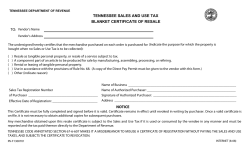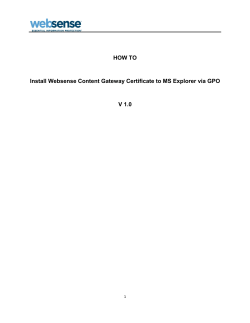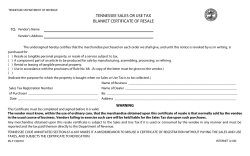
Sample Security Configuration for a Shibboleth IdP Author: Joe Boyle
Sample Security Configuration for a Shibboleth IdP Sample Security Configuration for a Shibboleth IdP Author: Joe Boyle Contributors: Gemma OʼDoherty & Ian Burgess Version 1.0 th 24 September 2008 - 1 - Sample Security Configuration for a Shibboleth IdP Contents Document Scope ........................................................................................ 3 Implementing and Securing the Shibboleth IdP in C2k ........................................... 4 Networking Tasks ...................................................................................... 5 Create a DMZ for the Shibboleth IdP Server .................................................... 5 Configure Firewalls ................................................................................. 5 Shibboleth Server Tasks ............................................................................... 7 Shibboleth Server Hardening ...................................................................... 7 Defining the Audit Policy ....................................................................... 10 Security Templates .............................................................................. 12 Security Patch Management & Anti-Virus Protection...................................... 13 Network Name Resolution ........................................................................ 13 Install and Configure the Shibboleth IdP Software ........................................... 14 Digital Certificate Tasks ............................................................................. 15 Pre-Requisites ...................................................................................... 15 Shibboleth Server Certificate Setup............................................................. 15 Certificate Request ................................................................................ 16 Importing the VeriSign Intermediate Certificate.............................................. 16 Importing the Shibboleth Certificate ........................................................... 16 Configure Shibboleth to use the new Certificate ............................................. 16 These guides have been prepared by organisations who participated in the JANET Shibboleth on Windows project. These guides are provided for general information purposes and are not intended to be definitive or exhaustive guides to the configuration, installation and implementation of Shibboleth On Windows. - 2 - Sample Security Configuration for a Shibboleth IdP Document Scope This document is a low-level technical document which describes and discusses a procedure for securing a Shibboleth IdP. - 3 - Sample Security Configuration for a Shibboleth IdP Implementing and Securing the Shibboleth IdP in C2k C2k is responsible for the provision of an information and communications technology (ICT) managed service to all schools in Northern Ireland. The process by which the Shibboleth IdP server was implemented and secured in C2k can be summarised as follows: 1. Networking Tasks a. Create a DMZ (De-Militarised Zone) for the Shibboleth IdP server b. Configure firewalls 2. Shibboleth Server Tasks a. Install the base operating system b. Harden the base operating system c. Network name resolution d. Install and configure the Shibboleth IdP software 3. Digital Certificates Tasks a. Request, Install and Configure a Digital Certificate on the Shibboleth IdP server Each of these tasks will now be discussed in more detail. - 4 - Sample Security Configuration for a Shibboleth IdP Networking Tasks In the C2k infrastructure, it is the network configuration and network components that are primarily responsible for ensuring the security of the Shibboleth IdP server. A dedicated DMZ was created to host the Shibboleth IdP server and both the internal and external firewalls were configured to allow the necessary network communications to flow. Create a DMZ for the Shibboleth IdP Server There are a number of options for the exact placement of a Shibboleth IdP server within an infrastructure. Figure 1 illustrates one of the most common network zone architectures for a Shibboleth IdP. Fig ure 1: Typical Network Zone Arch itecture for a Sh i bb oleth IdP In this solution the Shibboleth IdP Server resides in a DMZ. The DMZ is usually connected to a dedicated network interface on an external firewall. With this network configuration no direct access is allowed from the Internet to the Internal Infrastructure. The external and internal firewalls are configured to support the use of proxies and relays that reside in a DMZ. Rules on the external firewall control the communications that are allowed from the Internet to systems in the DMZ and vice versa. Rules on the internal firewall control the communications that are allowed from the DMZ to the Internal Infrastructure and vice versa. Configure Firewalls Table 1 records the rules for the external firewall. - 5 - Sample Security Configuration for a Shibboleth IdP Source Source Port * Target Target Port 53/UDP Action Comment Permit Allows the Shibboleth IdP to resolve names and IP addresses of systems on the Internet Shibboleth IdP * * 80/TCP Permit Allows the Shibboleth IdP to initiate HTTP communications with systems on the Internet Shibboleth IdP * * 443/TCP Permit Allows the Shibboleth IdP to initiate HTTPS/Secure Sockets Layer (SSL) communications with systems on the Internet * * Shibboleth IdP 8442/TCP Permit Allows systems on the Internet to initiate communications with the browser facing ports of the Shibboleth IdP * * Shibboleth IdP 8443/TCP Permit Allows systems on the Internet to initiate communications with the Service Provider facing ports of the Shibboleth IdP Shibboleth IdP External DNS Server Table 1: Firewall Rules for External Firewall Table 2 records the rules for the Internal Firewall. Source Shibboleth IdP Shibboleth IdP Source Port * Target * AD Domain Controller AD Domain Controller Target Port 88/TCP & 88/UDP Action Comment Permit Allows the Shibboleth IdP to initiate Kerberos communications with the AD Domain Controller 389/TCP Permit Allows the Shibboleth IdP to conduct LDAP queries against the AD Domain Controller Table 2: Firewall Rules for Internal Firewall - 6 - Sample Security Configuration for a Shibboleth IdP Shibboleth Server Tasks The first task to be performed on the Shibboleth IdP server is the installation of the base operating system. This can be performed in a number of ways – manual, scripted, imaged etc. Irrespective of which method is utilised, the Shibboleth server should be installed with a minimum number of components selected. Shibboleth Server Hardening The Shibboleth server is a web facing server and for this reason the security hardening applied to this server is in accordance with Microsoft Best Practice in relation to securing a web server. Although the Shibboleth IdP does not run the Microsoft IIS server, the Windows 2003 Operating System security hardening implementation in the Web Security Guide Best Practices is still the most appropriate baseline security implementation. In Windows Server 2003 SP1, Microsoft released the Security Configuration Wizard (SCW). The SCW provides a flexible, step-by-step process to reduce the attack surface on servers that run Windows Server 2003 with SP1. It quickly and accurately determines the minimum functionality that is required for the roles that specific servers must fulfil. It can create, test, troubleshoot and deploy security policies that disable all non-essential functionality. Finally it also provides the ability to roll back security policies. The SCW is used to accomplish the following tasks on the Shibboleth IdP Server: • • • Determine which services must be active, which services need to run when required, and which services can be disabled. Reduce the protocol exposure to the server message block (SMB)-based protocols, NetBIOS, Common Internet File System (CIFS), and Lightweight Directory Access Protocol (LDAP). Create useful Audit policies that capture the events of interest. The Shibboleth IdP server is not performing any of the standard based roles that a Windows server might do. For example, it is not a Domain Controller or a Certificate Server or File & Print Server. For this reason all roles are deselected. - 7 - Sample Security Configuration for a Shibboleth IdP The “DNS Client” & “Microsoft networking client” options are selected. In this example ten features have been selected; however there is scope to dramatically reduce this number depending on decisions yet to be made on managing the Shibboleth IdP server. - 8 - Sample Security Configuration for a Shibboleth IdP Next, a list of additional services that are required to support the server is presented. This will include hardware-specific services, anti-virus and patch management software etc. The list also includes the Tomcat5 web server which is a core part of the Shibboleth IdP software. Next, a decision must be made on how to handle Unspecified Services. In this example, the wizard is set to “Do not change the start-up mode of the unspecified service”. - 9 - Sample Security Configuration for a Shibboleth IdP The wizard then provides the option to review the resulting security policy of the settings which have been chosen. This illustrates how the SCW will disable services and re-define the startup mode of services. Defining the Audit Policy When defining the audit policy the “Audit Successful and Unsuccessful activities” option is selected. - 10 - Sample Security Configuration for a Shibboleth IdP An Audit Policy Summary is presented, prior to confirmation that the selections are correct. The Security Policy is saved to a file and stored under the following directory path: C:\Winnt\Security\msscw\policies\shibboleth.xml - 11 - Sample Security Configuration for a Shibboleth IdP Security Templates The Security Configuration Wizard can also integrate Microsoft template security files that are designed for servers that perform specific roles. A web server template “EC-Web Server.inf” is associated with the Shibboleth IdP Server. Additionally, a member server template file “EC-Member Server Baseline.inf” is included to tie down more general operating system issues. The template files are stored in C:\Winnt\Security. Finally you have the option to apply the security policy now or wait until later. - 12 - Sample Security Configuration for a Shibboleth IdP The advantage of using the SCW is that it allows you to roll back the policy changes from a single point of reference. It also allows you to generate an xml report that specifies in detail what security features are configured. To illustrate how extensive this is the reports runs to 30 pages for the Shibboleth server configuration. Security Patch Management & Anti-Virus Protection The Shibboleth IdP Server should also be configured with a patch management client to ensure that the latest Microsoft Security patches are always installing and running on the Server. The server should also use anti-virus software to protect against viruses and other security risks. Network Name Resolution Network name resolution must now be configured so that the Shibboleth IdP Server can identify and locate systems on the Internet and the Internal Infrastructure. DNS is configured so that the Shibboleth IdP Server resolves names from an external DNS server. The external DNS server could be one operated by an ISP, or alternatively it could be a dedicated external DNS server owned and operated by an internal IT group. In the case of C2k an added complexity is the use of the same DNS namespace (i.e. “c2ktest.net”) on both the Internal Infrastructure and the Internet. This configuration is often referred to as “split-brain DNS”. Figure 2 illustrates where the different zones in a split-brain DNS configuration would be hosted. - 13 - Sample Security Configuration for a Shibboleth IdP Fig ure 2: The Scope of DNS zones i n a split-brai n co nfi g uratio n Also, the DNS records stored in the internal and external zones will differ greatly: • • Internal DNZ zones contain entries for all internal systems e.g. file servers, workstations etc. External DNZ zones contain entries for all external systems e.g. web servers, Shibboleth servers etc. This setup presents a problem for the Shibboleth IdP Server because it needs to resolve names of systems on the Internet and resolve the name of a Domain Controller on the Internal Infrastructure. The Shibboleth IdP Server is setup to query an external DNS server which will know nothing about a Domain Controller in the Internal Infrastructure. A simple solution is to modify the “%windir%\System32\drivers\etc\hosts” file and add an entry for the Domain Controller which we want to locate e.g. 10.10.5.5 DC01.ACME.COM Install and Configure the Shibboleth IdP Software For detailed information on how to install and configure the Shibboleth IdP software please refer to the following document: “Integrating a Shibboleth IdP with Microsoft Active Directory”. - 14 - Sample Security Configuration for a Shibboleth IdP Digital Certificate Tasks An X.509 digital certificate is required to secure the network communications that take place between your Shibboleth IdP and other systems in the UK Federation. The digital certificate must be one of the X.509 digital certificate products recognised by the federation. As of September 2008, these are: • GlobalSign OrganizationSSL certificates • JANET Server Certificate Service (JANET SCS) certificates • TERENA Server Certificate Service (TERENA SCS) certificates • Thawte SSL web server certificates • UK e-Science CA host certificates • VeriSign Secure Site certificates More information on the process of getting a certificate can found at: http://www.ukfederation.org.uk/content/Documents/GetCertificate In the C2k environment, the digital certificate for Shibboleth was purchased from VeriSign. The remainder of this section discusses the process which C2k used to complete the installation. Pre-Requisites A Shibboleth IdP is a system which must be locatable on the Internet. It therefore requires a fully-qualified name e.g. shibboleth.acme.com. In the C2k environment there are a number of separate infrastructures e.g.: • • • Production Pre-Production Development & Test Within this section we discuss the process of linking the “Development & Test” infrastructure into the UK Federation. The Pre-Production and Production environments will be brought into the UK Federation in later stages of the Shibboleth project. For the C2k Development and Test infrastructure it was decided that the Shibboleth IdP server would be known on the Internet as “shibboleth.c2ktest.net”. The domain name “c2ktest.net” was registered by C2k. An externally contactable IP Address (85.31.137.110) was then bound to the newly registered “c2ktest.net” domain and an alias record created for “shibboleth.c2ktest.net”. VeriSign requires this information to be publicly available via a DNS registration host before it can verify the requesting party. Shibboleth Server Certificate Setup The C2k environment uses a Java based certificate, generated by the keytool utility. The certificate is then signed by VeriSign, which provides the follow security features: - 15 - Sample Security Configuration for a Shibboleth IdP • • • Encryption of sensitive information during online transactions Authenticated information about the certificate owner Verifies the identity of the certificate owner when it is issued A Java keystore is created using the keytool utility and is stored in a secure directory on the Shibboleth server: C:\Program Files\Internet2\Idp\Etc Certificate Request A Certificate Signing Request (CSR) is then generated against the Java keystore and is submitted to VeriSign via their web site. The information provided in the CSR must meet a specific format and must be verifiable by VeriSign before it will sign the CSR submitted. Once verification has been completed VeriSign emails the signed certificate to a registered contact. The returned signed Certificate is chained with the VeriSign Intermediate Certificate. C:\Program Files\Internet2\CaptiveJava\bin\keytool -certreq -keyalg RSA alias Shibboleth -file "c:\Program Files\Internet2\Idp\Etc\certreqc2k.csr" -keystore "c:\Program Files\Internet2\Idp\Etc\C2k.jks Importing the VeriSign Intermediate Certificate The VeriSign Intermediate CA certificate is imported into the Java keystore with the Keytool utility: C:\Program Files\Internet2\CaptiveJava\bin>keytool -import -alias intermediateCA -keystore "c:\Program Files\Internet2\Idp\Etc\C2k.jks" trustcacerts -file "c:\Program Files\Internet2\Idp\Etc\VeriSignInterCA.crt" Enter keystore password: ************* Certificate was added to keystore Note: there is no requirement to import the VeriSign Root certificate because this is already present on all browsers. Importing the Shibboleth Certificate The signed Shibboleth certificate is imported into the Java keystore with the Keytool utility: C:\Program Files\Internet2\CaptiveJava\bin>keytool -import -alias Shibboleth -keystore "c:\Program Files\Internet2\Idp\Etc\C2k.jks" trustcacerts -file "c:\Program Files\Internet2\Idp\Etc\c2kcert.cer" Enter keystore password: ************* Certificate reply was installed in keystore Configure Shibboleth to use the new Certificate Shibboleth must now be configured to use the new certificate. The resultant configuration secures communication traffic between users’ Internet browsers and the Shibboleth server. The server.xml file is modified in order to facilitate this: - 16 - Sample Security Configuration for a Shibboleth IdP C:\Program Files\Internet2\CaptiveTomcat5.5\conf\server.xml Two lines are added to the file: keystoreFile="C:\Program Files\Internet2\\Idp\etc\c2k.jks" keystorePass="password" The keystoreFile parameter provides the path to the keystore where the signed certificate can be located. The keystorePass parameter provides the keystore password. These modifications bind the Shibboleth certificate to port 8442. This is the port that the Shibboleth IdP uses to respond to IdP traffic via a web browser. Any communication taking place between a browser and the Shibboleth server will do so via secure SSL encryption with a certificate that VeriSign has verified issued to C2k. Disclaimer This guide is provided by JANET(UK) for general information purposes only and the JNT Association cannot accept any responsibility and shall not be liable for any loss or damage which may result from reliance on the information provided in it. - 17 -
© Copyright 2025









